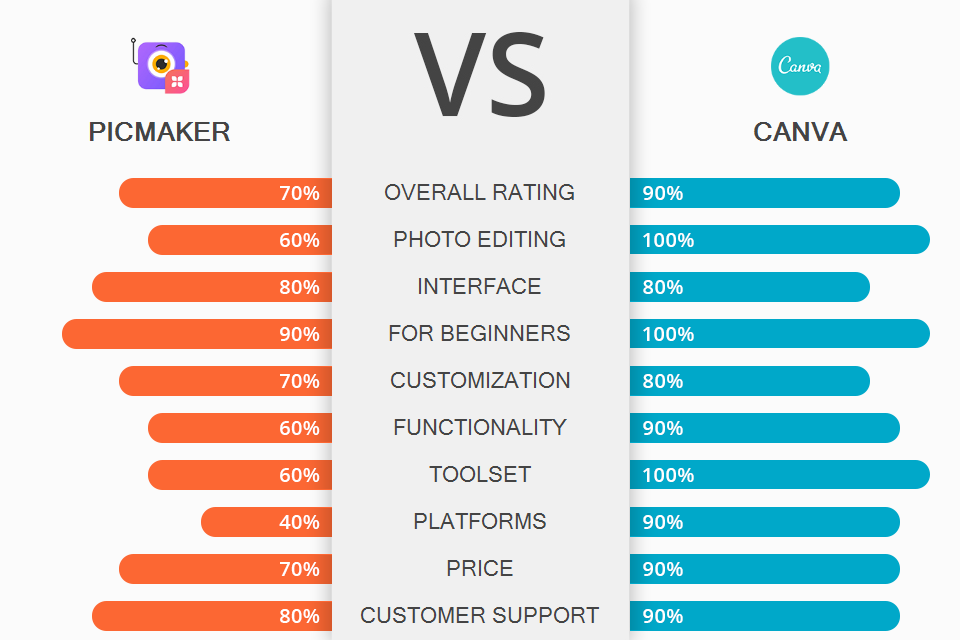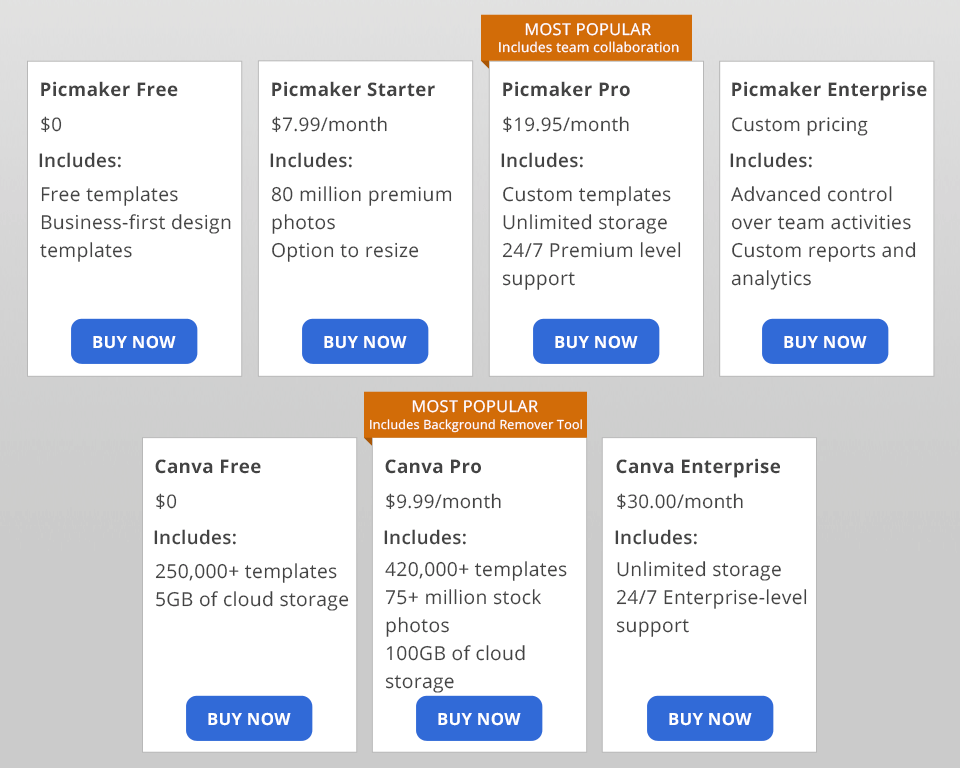Many users have difficulties deciding between Picmaker vs Canva as both programs allow creating YouTube banners and thumbnails.
Picmaker is a software with a vast array of templates that let users add different backgrounds, stickers, pictures, color gradients, etc. to their designs. Its collaborative and sharing capabilities are impressive as well.
Canva is a sophisticated free graphic design software that can satisfy any of your visual content creation needs. It is a go-to tool for many experienced and novice users who prefer Canva’s straightforward interface and ready-made templates.
Free background remover. The offered AI-powered remover tool copes greatly with the background elimination task, making the software an excellent YouTube banner maker. In a single click, the background will be gone for good.
MAD button. If you don’t know which font, color or background element to pick, Picmaker will suggest you several options. Thanks to the power of artificial intelligence, any design can acquire a whole new look.
Free templates. Apart from providing a vast selection of free templates, Picmaker also categorizes them according to the theme, like marketing, social media, education, sales, etc. Each template is fully editable so that you can create your dream design.
100 million stock images. You will have millions of stock pictures at your disposal, and you won’t need to turn to stock photography sites anymore. The stock library contains all sorts of pictures in order to cater to different designing needs.
Free premium icons. The collection of icons is no less incredible, letting you find a perfect icon for your poster, logo or just any design you have in mind.
Brand kits. To help you maintain strong brand identity, Picmaker offers the ability to import your own fonts, colors and logo for further use.
Get links. If you want the members of your team to view or edit the design in Picmaker, simply copy and send its link to them.
Share and collaborate. The created design can be shared with anyone – your family, friends or colleagues. That is how Picmaker facilitates the cooperation process.
Stickerify tool. This tool is capable of converting pictures into gorgeous stickers. When used appropriately, these small elements add visual appeal to banners, thumbnails and other designs.
Fonts. Either upload your own font or choose a suitable one from an extensive selection of fonts provided by Picmaker.
Shapes & frames. Up your design game with fully customizable gradient shapes, frames, objects and characters found in Picmaker. Their variety is impressive.
Lacks a mobile version. Unfortunately, Picmaker provides only the web version, and there is no mobile application right now.
Only for editing. In Picmaker, you can only edit picture files. Comparing Picmaker versus Canva, the latter wins over in this context since it supports working with video format, animation and music.
Perfect for newbies. If you are a novice designer, you will appreciate Canva’s straightforward interface. To get a grasp of it, you won’t even have to explore tutorials.
Create various types of content. Regardless of the kind of design you are after, for instance, a social media post, a CV or infographics, Canva can take it all. Creating designs from the ground up is possible as well.
Drag and drop feature. Thanks to the drag and drop functionality, adding templates and pictures to the design will be a breeze.
Teamwork. If you are working in a team, collaborate on a Canva project in real-time. It is a superb free logo maker to design presentations, Instagram posts or company logos collectively when the entire team is involved. For remote work, Canva allows creating a shared workspace.
Templates. Canva deserves praise for its comprehensive library of more than 50,000 fully editable templates. The library is continuously being updated with new templates.
Photo editing. Aside from regular cropping and texturing of pictures, Canva lets users add text, apply blur effects, create picture grids and collages – basically everything you may need to bring your design idea to life.
Stocks pictures, icons and fonts. Canva presents a collection of free stock pictures, icons and fonts for your designing experiments. If you wish to add your own picture to the design, feel free to upload it to Canva.
Convenient mobile applications. When choosing between Picmaker or Canva, mind that the latter offers mobile versions for iOS and Android. All the picture- and text-combining manipulations are found in online, mobile and desktop Canva versions.
Advanced video options. Canva isn’t only a wonderful graphic design software. It serves as an excellent video editor as well, making it possible to crop, trim, cut, flip and split footage.
Besides, you are given the ability to add pages to the video stitch along with access to free audio tracks. Using the animation capabilities, apply transition effects and animated text stickers.
User-friendly interface. It is a pleasure to navigate through Canva’s interface as it is incredibly intuitive.
Grids for templates, pictures, stickers and backgrounds are located on the left side. On the top panel, you may spot tabs for fonts, color palettes and a formatting toolset. The drag-and-drop functionality lets you pick up the tool and apply it in a couple of clicks.
Canva doesn’t have local file storage. Due to this, in case of the Canva website’s downtime, the designs will be inaccessible during that period.
Overuse of designs. Your design might not be very unique, especially if you see that same template being used in other web projects. To avoid this, make sure to tweak the template as much as possible and adapt it to your particular needs.
No source file. While programs like Photoshop, Illustrator or InDesign allow editing, sharing or exporting files without a dedicated account, the same isn’t true for Canva. You won’t be able to edit the design as a raw file at a more professional level.
Picmaker offers its users 4 packages:
A Free plan comprises business-first design templates, numerous free pictures and graphics.
The Starter plan ($7.99/month) presents all the features of the Free plan, a brand kit with the ability to import colors, logos, fonts, as well as a collection of 80 million premium pics.
The Pro plan ($19.95/month) unites the benefits of the Starter plan, file organizer and folder structure, collaborative and team management capabilities, unrestricted storage, single-sign-on (SSO), and round-the-clock premium level support.
The Enterprise plan (price is different for each customer) provides all the features mentioned above along with the integrated workflow management, a specially assigned account manager and a team to help you enhance your designs.
Canva offers three packages:
A Free plan gives you 250,000+ templates, support for various formats, sharing capabilities, 5 GB of storage.
The Pro plan will please you with 420,000+ templates, downloadable logos, brand colors and fonts, downloadable video, 100 GB of storage. If you opt for an annual subscription, Canva will cost you $9.99 a month for individual use.
The Enterprise plan is ideal for large teams and organizations. It boasts all the perks of the Pro plan but with increased storage space. The monthly price is $30.00 for individual use if the selected subscription is annual.
These two programs are equally efficient when it comes to the creation of remarkable designs. Both of them are rather inexpensive and beginner-friendly. But as you can see from this Picmaker vs Canva comparison, the toolset of the latter accommodates the needs of proficient users as well.
Despite being free, Picmaker won’t place any watermark on the created design, like Canva and other YouTube thumbnail makers may do.
Canva boasts the ability to manipulate pictures, videos, animations and audio. The provided storage is large enough to sustain all your projects. If having a mobile application is important for you, stick to Canva since Picmaker has a web version only.



